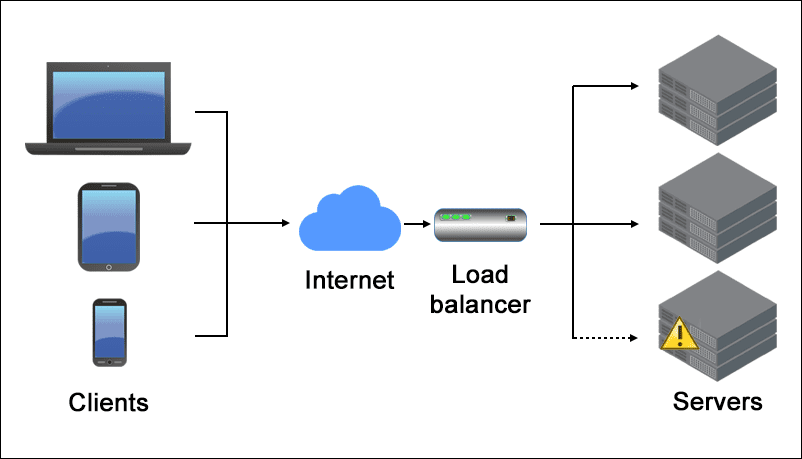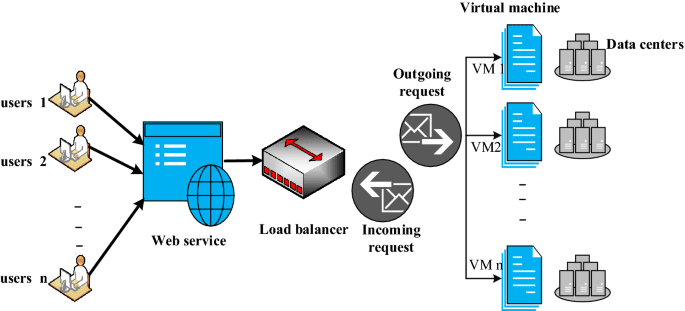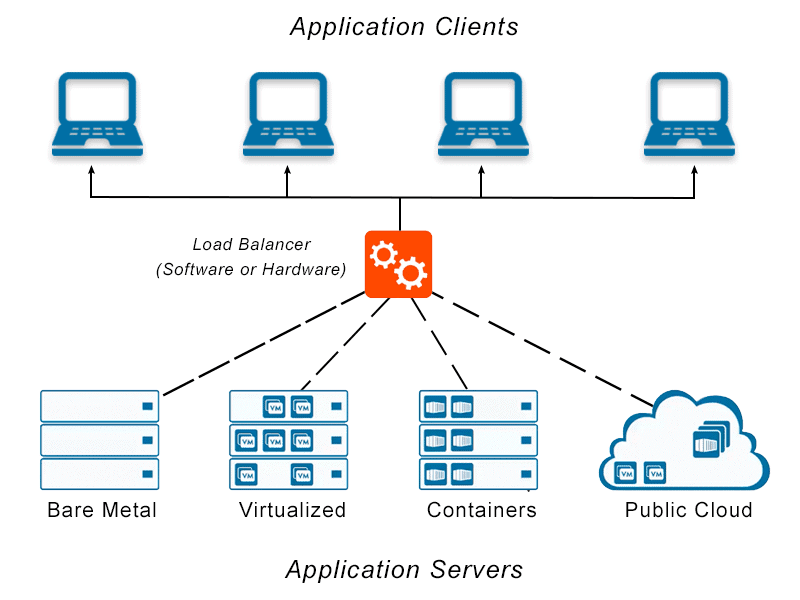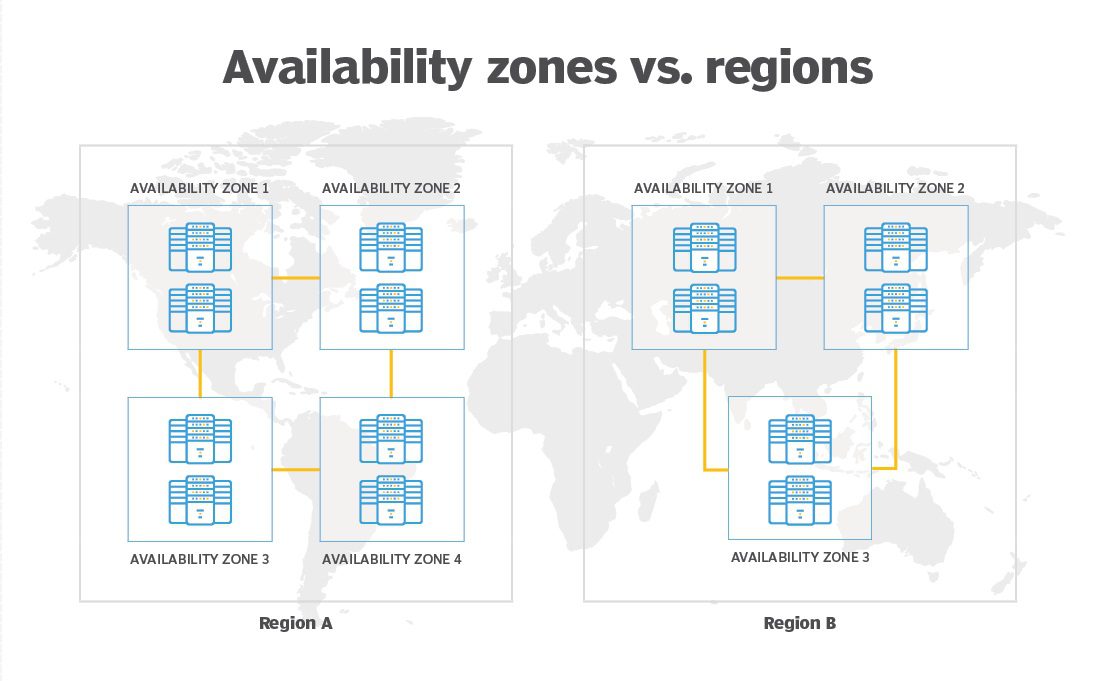What is a Load Balancer?
A Load Balancer is a system provided as a service that balances traffic by distributing it appropriately across the servers of an application or website to ensure availability and stability.
The primary goal of a Load Balancer is to prevent any single server from becoming overloaded. It not only distributes traffic rationally but also ensures the system operates stably and smoothly.
What is a Load Balancer System?
A Load Balancer is a device that functions as a reverse proxy, distributing network or application traffic across multiple backend servers. It is used to increase the concurrent capacity of distributed systems by enhancing availability and performance. It improves overall application performance by reducing the burden on servers related to managing and maintaining application and network sessions, as well as performing application-specific tasks.
Load balancing is divided into two categories: L4 and L7. L4 operates at the network level (Network & Transport layers), optimizing packet flows through protocols such as IP, TCP, FTP, etc. L7 operates at the application level, optimizing HTTP requests, APIs, etc.
A Load Balancer can be:
- A physical device or a virtual instance running in a distributed system.
- Integrated into an Application Delivery Controller (ADC) designed to broadly improve performance and security at the microservices level.
- A cluster of multiple Load Balancers operating on different algorithms based on system use cases.

How Does a Load Balancer Work?
A Load Balancer is a critical network component that distributes traffic and ensures application availability. Below is a detailed explanation of how it works:
Basic Principle
The Load Balancer receives all user requests and distributes them to backend servers based on a specific strategy. This prevents any single server from becoming overloaded and ensures optimal performance for the entire system.
Common Load Balancing Algorithms
- Round Robin
How it works: The Load Balancer distributes requests to backend servers in a circular order.
Advantages: Simple and easy to implement.
Disadvantages: Does not account for the current load on each server, potentially leading to uneven load distribution when requests vary in size.
- Least Connections
How it works: The Load Balancer directs requests to the server with the fewest active connections.
Advantages: Ideal for systems with long and uneven processing times per connection.
Disadvantages: Requires continuous monitoring of connection counts, which can be more complex.
- IP Hash
How it works: Distributes requests based on the user’s IP address, using a hash function to determine the target server.
Advantages: Ensures consistent routing of the same IP to the same server, useful for applications requiring session persistence.
Disadvantages: Adding or removing servers may require recalculating the distribution.
Types of Load Balancers
Load Balancers are vital for distributing traffic and ensuring application availability. Below are the common types of Load Balancers and their characteristics:
| Type | Characteristics | Advantages | Disadvantages |
|---|---|---|---|
| Hardware | Dedicated devices with high performance and built-in security features. | – High performance and reliability.<br>- Includes advanced features. | – High initial investment costs.<br>- Less flexible. |
| Software | Runs on standard servers, flexible, easy to deploy and configure, supports multiple algorithms and integrates with monitoring tools. | – Lower cost.<br>- Easily scalable and configurable. | – Dependent on server hardware resources.<br>- May not match hardware performance. |
| Cloud-based | Provided by cloud service providers, auto-scalable, integrates with other cloud services. | – Easy to deploy and manage.<br>- Auto-scaling and fault recovery.<br>- Pay-per-use, cost-efficient. | – Dependent on cloud providers.<br>- Potential performance and latency issues compared to hardware. |
Choosing the right Load Balancer depends on your system’s specific needs and budget. Hardware Load Balancers are ideal for systems requiring high performance and reliability, while software and cloud-based Load Balancers offer flexibility and ease of deployment.
Benefits of Using a Load Balancer
Using a Load Balancer provides significant benefits for network systems and applications. Key advantages include:
Improved System Performance
- Even traffic distribution: The Load Balancer distributes requests across multiple backend servers, preventing any single server from becoming overloaded, optimizing server performance, and ensuring smooth system operation.
- Resource optimization: By dividing tasks among multiple servers, the Load Balancer speeds up request processing, enhancing the user experience.
Enhanced Availability and Fault Tolerance
- Server redundancy: If a server fails, the Load Balancer automatically redirects traffic to other servers, ensuring continuous system availability despite hardware or software issues.
- Automatic fault recovery: The Load Balancer continuously monitors backend server status and removes unavailable servers from the load balancing pool.
Increased Security
- Blocking malicious requests: The Load Balancer can filter out harmful requests before they reach servers, protecting the system from external attacks.
- Integrated security features: Many Load Balancers include features like Web Application Firewalls (WAF) and DDoS protection, enhancing system security.
Efficient Management
- The Load Balancer manages server resources effectively, distributing workloads rationally and minimizing resource waste.
- Cost savings: By optimizing resources and automating processes, Load Balancers reduce operational and maintenance costs.
Key Components of a Load Balancer
A Load Balancer system typically includes the following components:
- Frontend and backend servers: The frontend receives user requests, while backend servers process them.
- Health checks and monitoring: Monitors the operational status of backend servers to ensure they are always available.
- SSL termination: Decrypts SSL/TLS connections at the Load Balancer, reducing the workload on backend servers.
- Session persistence: Ensures requests from the same user are routed to the same server.

Real-World Applications of Load Balancers
Load Balancers have numerous practical applications in network systems and applications, optimizing performance and ensuring availability. Key applications include:
- Smooth website operation: Load Balancers distribute access requests to multiple backend web servers, reducing the load on each server and ensuring websites run smoothly even during high traffic.
- Reduced response times: By dividing tasks among servers, Load Balancers decrease response times, improving user experience for websites or web applications.
- Stable cloud services: Load Balancers help cloud services distribute resources efficiently, ensuring stable operation without overload.
- Easy scalability: With automatic traffic distribution and adjustment, Load Balancers enable cloud services to scale effortlessly to meet growing demand.
Load Balancing in Microservices and Container Environments
- Performance optimization: In microservices architectures, small services are often deployed as containers. Load Balancers distribute requests across containers, optimizing performance and resource use.
- Ensured availability: If a container or microservice fails, the Load Balancer redirects requests to other containers, ensuring system availability.
Setting Up and Managing a Load Balancer
To set up and manage a Load Balancer, follow these steps:
- Basic setup and configuration: Connect the Load Balancer to the network, configure backend servers, set up load balancing algorithms, and enable security features.
- Management and optimization tools: Use monitoring and management tools like Zabbix or Nagios to track Load Balancer performance and status.
- Tips and considerations: Regularly check and update Load Balancer software, monitor backend server status, and adjust configurations as needed.
Choosing the Right Load Balancer
When selecting a Load Balancer, consider the following factors:
- Performance: Ensure the Load Balancer can handle your system’s network traffic.
- Features: Choose a Load Balancer with features like SSL termination, health checks, and session persistence that match your needs.
- Cost: Compare the investment and operational costs of different Load Balancer solutions.
Load Balancer Solutions for Businesses
- Nginx: A popular, flexible, and high-performance software Load Balancer.
- HAProxy: A powerful software Load Balancer with extensive features and detailed configuration options.
- AWS Elastic Load Balancing: Amazon’s cloud-based Load Balancer, easy to deploy and scale.
- Sun Load Balancer: Sun Load Balancer is a load balancing solution that evenly distributes traffic across a group of servers, enhancing system stability, minimizing downtime, and simplifying monitoring.
Integrated seamlessly with Sunteco’s virtual server rental services, Sun Load Balancer supports large-scale application systems by enabling server scalability, thereby improving load-handling capacity. It is an ideal solution for optimizing performance and ensuring continuous operation for high-traffic systems. Sun Load Balancer supports multiple protocols, including HTTP/HTTPS, TCP, and UDP, making it suitable for various system architectures, including microservices and containers. It automatically distributes requests across multiple servers, enabling higher fault tolerance, seamless operation, and essential load balancing for application traffic. Additionally, Sun Load Balancer automatically checks server availability and redirects requests to available servers if any become unavailable, ensuring continuous service.
Benefits of Sun Load Balancer
- Rapid deployment: Set up a load balancing system in seconds without investing in infrastructure or extensive configuration efforts.
- Easy scalability: Instantly adjust configurations, built on Sunteco Cloud’s infrastructure with unlimited scalability.
- Protocol support: Supports diverse protocols (HTTP, HTTPS, TCP, UDP) to flexibly meet customer needs.
- Flexible routing: Routes traffic to destinations based on domain names, paths, and content dynamically.
- Sticky sessions: Ensures user requests are consistently routed to the same backend server, maintaining data integrity for connected sessions.
- Activity monitoring: Continuously monitors and updates backend server activity, displaying status for users.
Try Sun Load Balancer for free: https://dashboard.sunteco.vn/
Conclusion
We hope this article has provided a clear understanding of what a Load Balancer is. Load Balancers play a crucial role in ensuring system performance and availability. Choosing and using a Load Balancer correctly optimizes resources, enhances performance, and improves security for network applications and services. We hope this article helps you better understand Load Balancers and apply them effectively to your system for optimal results. For further consultation on free Load Balancer solutions, contact Sunteco at Hotline: (+84) 78 678 3868.










